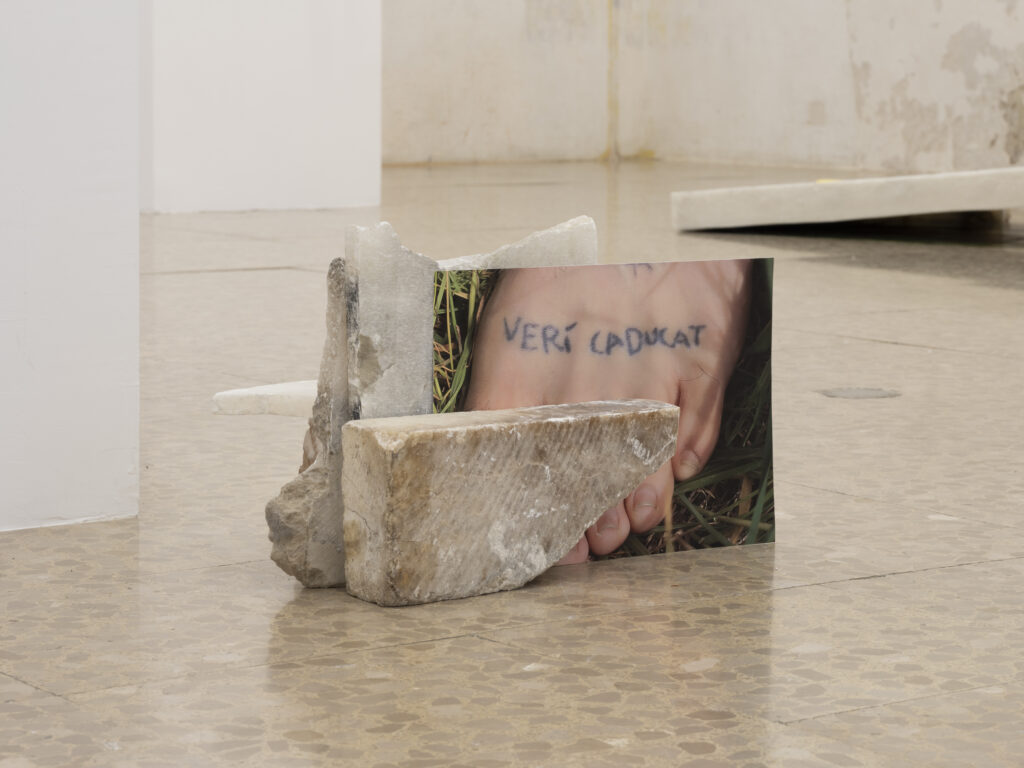«In a drop of water
The little boy was looking for his voice.
I do not want it for speaking with;
I will make a ring of it
So that he may wear my silence
On his little finger».El niño mudo (Canciones 1921-1924), Federico García Lorca
A small finger.
Barely there.
Like the shape that lingers and then white. And then green.
Like the voice that follows.
In that touch, to cease being stone.
Or flesh.
Or human.
To be something else.
In the exhibition Mi voz en su dedo más pequeñito, Mikel Adán Tolosa presents the sculptural surface as a site of encounter between bodies. A meditation on the possibility of touching emptiness with one’s hand. Searching for the voice, like in the song, in a drop of water. Searching with a hand so small it cannot quite reach the edges.
Here, the relationship between surfaces reveals itself to be more complex than it first appears. It becomes a question of cohabitation, of allowing oneself to be affected by nameless forms, by materials that refuse to fit into categories. The forms shift from their native territories. As the artist suggests, forms become more animal when they were once vegetal, more mineral when they were animal, more human when they were artificial. By altering the logic of the original material, a new language emerges, along with new modes of relation: the objects, the images, the sculptures, do not exist separately before they relate—they arise through their interrelation.
Mi voz en su dedo más pequeñito also originates from the gesture of resizing bodies. Like whispering to a very small object, Mikel enlarges and reduces forms, and thus between sculpture and image, parallel versions emerge. The pieces—of salt, alabaster, butter…—do not hide their materiality, but neither are they confined by it. A votive marble foot reduced to a postcard, an oversized hand holding a tiny river fish, a pedestal that also becomes a landscape.
The sculptural composition in this exhibition creates a fragmented map that questions the hierarchy between base and figure. The pedestals, stripped here of their usual display function, act instead as platforms with a horizon-like intent, modulating how forms approach us. This engagement with scale activates a perceptual estrangement that defamiliarizes the original forms. Some appear to be marble, but are salt; others retain the marks of the process that shaped them—from mold work to chisel and cut marks on the stone—while others still hold the vibration of a gesture or a photograph. Everything seems to retain some trace of its metamorphosis.
The layering of objects and images within this landscape introduces an added dimension to how the works are read. Some pieces combine photography and sculpture, others juxtapose materials from entirely different registers. This strategy allows a single form to take on multiple identities, depending on what it’s paired with or where it’s placed. The works are thus presented as layers that affect one another and generate new meanings. Like the fossil of a sea creature turned to stone, the same form may carry two identities. Or three. Or more.
And once again a small finger.
Barely there.
The suspended voice
tries to remain there.
In the touch,
and in the touch, change form.
Cease to be a recognizable substance.
No longer stone.
Nor flesh.
Nor human.
To be, at last, something else.
Exhibition by Mikel Adán Tolosa at Dilalica. Curated by Sergi Álvarez Riosalido. From June 25 to July 31, 2025.
